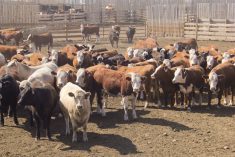Live cattle prices have been under pressure since peaking in December amid bullish headlines and news that took prices to historic highs.
Cattle and calves in the U.S., according to U.S. Department of Agriculture estimates as of Jan. 1, totaled 89.3 million head — two per cent below the 90.8 million figure recorded a year earlier. That makes this Jan. 1 inventory of all cattle and calves the lowest since 1952, when 88.1 million were on hand.
All cows and heifers that have calved are also estimated to be down two per cent at 38.5 million head. This is the lowest Jan. 1 inventory of all cows and heifers that have calved since 1941 when there were 36.8 million head.
Read Also

U.S. livestock: Feeder cattle hit contract highs on tight supply
Chicago | Reuters – All Chicago Mercantile Exchange feeder cattle futures and most live cattle futures hit contract highs on…
The 2012 calf crop is estimated to be down three per cent from 2011 at 34.3 million head. This is the smallest calf crop since 1949, when there were 33.7 million born.
These staggering statistics, along with the seasonal tendency for cattle prices to strengthen into March, gave many in the cattle trade the expectation of even higher prices in 2013. However, that was not to be, as prices dropped $13 per hundredweight (cwt) in the first 90 days of 2013.
This is a classic example of a market topping out when the news is the most bullish. All the while, the charts were depicting a different tale.
It started with a reversal pattern called a tweezer top. As illustrated in the accompanying chart, this sell signal develops when a market posts the same high two days in a row. In fact, $138 turned out to be the exact high on the April contract.
Shortly thereafter, prices made one last attempt to go higher, only to fail and develop a two-day reversal. This is also a reversal pattern seen at market tops and bodes well to alert savvy traders and livestock producers of an impending downturn.
Prices quickly slipped below the lower boundary (A) of the uptrending channel and ran sell stops, which in turn drove prices down another $5/cwt to $129.
The damage was done. Other than the occasional bounce, prices continued to drift lower within the parameters of the downtrending channel.
Market psychology: The tweezer top and two-day reversal depict a complete change in attitude. On the first day the longs are comfortable and confident. The market’s performance provides encouragement and reinforces the expectation of greater profits. The second day’s activity is psychologically damaging. It is a complete turnaround from the preceding day and serves to destroy or at least shake the confidence of many who are still long the market. The immediate outlook for prices is abruptly put in question. Longs respond to weakening prices by exiting the market.
In an uptrending channel, the market rallies and then reacts to uncover underlying support. This process, once set in motion, develops a momentum which strengthens the trend and makes it persist. After a period of upward movement, one must be on the alert for any subtle changes in this repetitive process, as they will show up clearly on the charts. When rallies begin to fall short of the upper channel boundary, it is a clue that the existing trend may be waning.
At this juncture, the demand which had trailed the market is being absorbed. When the price finally does turn down for real, trendlines will be quickly broken because the demand has either been totally satisfied or the volume of selling simply overpowers what little buying remains.
As I’ve illustrated here, technical analysis indicates a change in trend long before the fundamental information substantiates it. Three months later and $13 lower, the news reflects the fact cattle prices are falling due to the unavailability of feed and subsequent herd liquidation.
There will be better days ahead — but not until the liquidation is over and the trend turns back up.
Send us your questions or comments about this article and chart.
— David Drozd is president and senior market analyst for Winnipeg-based Ag-Chieve Corp. The opinions expressed are those of the writer and are solely intended to assist readers with a better understanding of technical analysis. Visit Ag-Chieve online for information about grain marketing advisory services, or call us toll-free at 1-888-274-3138 for a free consultation.
















